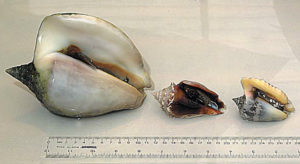
Sediment accumulation in channel catfish production ponds
We sampled pond bottom sediments from 45 commercial channel catfish ponds that were in production for 14 days to 21 years.
Two nutrient elements, nitrogen and phosphorus, are responsible for eutrophication in most instances. Phosphorus is usually the key factor.

We sampled pond bottom sediments from 45 commercial channel catfish ponds that were in production for 14 days to 21 years.

Some producers take advantage of shrimp's ability to tolerate a broad range of salinity variations by rearing in low-salinity waters.

A benefit of aeration is the mixing of pond water. Similar to biotechnological reactors, microbial processes are more effective in mixed pond water.

Tilapia-shrimp polyculture may provide an opportunity to re-establish a profitable and more sustainable aquaculture system at these dormant facilities.

In shrimp farming it is critical to ensure that residual nitrogen waste is minimized or eliminated prior to discharge into receiving waters.

Solids in water are either in true solution or suspended. Suspended solids remain in suspension because they are so small and light.

The pH of shrimp pond water is influenced by source water, pH and acidity of bottom soil, shrimp culture inputs and biological activity.

Although controversial, the potential benefits of genetically modified fish and shellfish can yet be realized, while minimizing risks to human health and the environment.

Recirculation systems not only limit environmental impact but can produce several species at once with minimal space requirements.

Family shrimp farms are common in Southeast Asia, where costs of living are low and revenue from one or two small ponds can support a family.

The history of how aquaculture's connection to the National Pollution Discharge Elimination System of the Clean Water Act is an interesting topic.

The queen conch (Strombus gigas) is a large marine gastropod that has supported subsistence and commercial fisheries in these areas for centuries.

Appropriate site selection, design and management are fundamental factors that contribute to the success or failure of a shrimp farm.

GAA's Responsible Aquaculture Program requires shrimp farmers to install certain practices, keep records on activities and satisfy effluent water quality standards.

Natural waters have a very complex chemical composition and may contain almost any substance found in the atmosphere, in the Earth’s crust, or in living organisms.